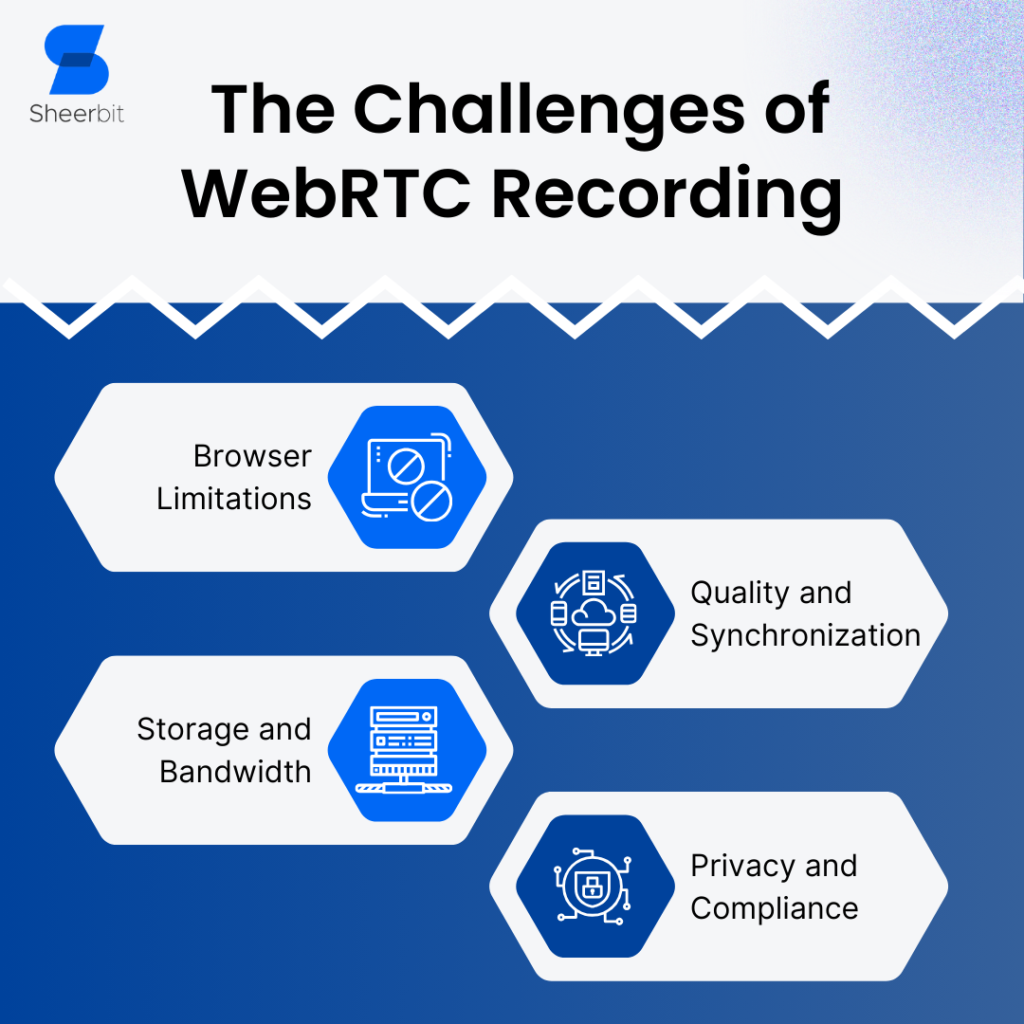WebRTC (Web Real-Time Communication) has become a potent tool in the quickly changing world of online communication, enabling real-time audio and video communication directly within web browsers. Our online interactions have been completely transformed by its smooth integration with web apps, which makes everything from live streaming to video conferencing simple.
While WebRTC has many advantages, such as reduced latency and high-quality audio and video, recording is one area that frequently presents difficulties. It can be difficult to capture WebRTC streams for viewing or archiving later, necessitating careful consideration of several elements. In this blog article, we’ll examine methods to overcome the difficulties that occur with WebRTC recording.

Understanding the Challenges
1. Browser Limitations:
WebRTC broadcasts are difficult to capture because of browser security limitations, in contrast to standard media streams. Developers trying to incorporate recording functionality face major obstacles.
Pros:
User privacy is safeguarded, and security measures implemented by browsers avoid unauthorized access to streams.
Cons:
Due to these limitations, client-side recording solutions are difficult to deploy and need the use of server-side recording or other alternative strategies.
2. Quality and Synchronization:
Keeping recorded WebRTC streams synchronized and high-quality can be difficult, particularly when there are several participants or network circumstances change.
Pros:
Ensuring synchronized and high-quality recordings guarantees a smooth playing experience for consumers.
Cons:
Maintaining consistency in quality and synchronization might be challenging, especially when several participants or different network circumstances exist.
3. Storage and Bandwidth:
It can take a lot of resources to store and manage recorded WebRTC data, especially for large-scale applications with many concurrent users.
Pros:
Solutions for cloud-based storage provide scalability and dependability, enabling businesses to handle stored material effectively.
Cons:
It can take a lot of resources to store and maintain large volumes of WebRTC data, and using bandwidth may incur additional costs.
4. Privacy and Compliance:
Recording user interactions raises privacy problems, and compliance with laws like HIPAA (Health Insurance Portability and Accountability Act) and GDPR (General Data Protection Regulation) may be required.
Pros:
Adherence to privacy standards, such as GDPR and HIPAA, is ensured by making privacy a priority in designing and implementing permission processes.
Cons:
Recording user interactions presents privacy issues and necessitates careful consideration of compliance and data protection regulations.
Overcoming the Challenges
1. Server-Side Recording:
By using server-side recording systems, one may maintain constant quality and synchronization while exceeding browser limits. Developers may exceed browser limitations and streamline the recording procedure through server-side stream capture.
Pros:
Server-side recording solutions provide constant quality and synchronization while getting beyond browser restrictions.
Cons:
Server-side recording may increase development complexity and costs by requiring more infrastructure and knowledge to implement.
2. Media Server Integration:
WebRTC recording may be made easier by utilizing media server systems like Kurento or Janus, which offer integrated recording features and strong API support. These solutions’ capabilities, which include adaptive bitrate encoding and selective stream recording, improve users’ recording experiences.
Pros:
Platforms for media servers simplify the recording process by providing strong API support and integrated recording features.
Cons:
Implementing integration with media servers requires careful attention since it may produce dependencies and compatibility difficulties.
3. Optimized Storage Solutions:
Recording significant amounts of WebRTC data can present storage and bandwidth issues, which can be resolved by using cloud storage services like Google Cloud Storage or Amazon S3. Cloud-based storage solutions provide scalability and dependability, allowing developers to effectively handle stored material.
Pros:
Cloud storage services offer scalable and dependable storage options for recorded WebRTC data.
Cons:
Significant amounts of data storage on cloud servers may result in extra expenses and privacy and security issues.
4. Privacy by Design:
It is imperative to prioritize privacy and compliance issues when implementing WebRTC recording capabilities. Adopting features like data encryption, access restrictions, and permission methods can help reduce privacy threats and guarantee legal compliance.
Pros:
To ensure that rules are followed, I’m enforcing access limits and prioritizing privacy issues.
Cons:
Trade-offs between user experience and data accessibility may be necessary to strike a balance between privacy constraints and recording functionality.
Conclusion
In conclusion, WebRTC recording has its share of difficulties, but developers may get over these problems and realize the full potential of WebRTC technology with proper preparation and the appropriate tools in place. Organizations may expedite the recording process and provide flawless user experiences by utilizing server-side recording, connecting with media server systems, optimizing storage solutions, and placing a premium on privacy by design.
Ready to unlock the full potential of WebRTC recording and elevate your online communication experience? Contact us for knowledgeable advice on how to overcome WebRTC recording obstacles. Give your web apps flawless recording capabilities to remain ahead of the always-changing online communication scene.





